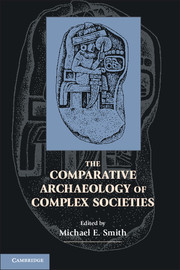Book contents
- Frontmatter
- Contents
- Tables
- Figures
- Contributors
- Foreword
- Preface
- Chapter 1 Comparative Archaeology
- Chapter 2 Approaches to Comparative Analysis in Archaeology
- Chapter 3 Comparative Frames for the Diachronic Analysis of Complex Societies
- Chapter 4 What It Takes to Get Complex
- Chapter 5 Challenges for Comparative Study of Early Complex Societies
- Chapter 6 Patterned Variation in Regional Trajectories of Community Growth
- Chapter 7 The Genesis of Monuments in Island Societies
- Chapter 8 Power and Legitimation
- Chapter 9 The Strategies of Provincials in Empires
- Chapter 10 Household Economies under the Aztec and Inka Empires
- Chapter 11 Low-Density, Agrarian-Based Urbanism
- Chapter 12 Archaeology, Early Complex Societies, and Comparative Social Science History
- Index
- References
Chapter 10 - Household Economies under the Aztec and Inka Empires
A Comparison
Published online by Cambridge University Press: 07 October 2011
- Frontmatter
- Contents
- Tables
- Figures
- Contributors
- Foreword
- Preface
- Chapter 1 Comparative Archaeology
- Chapter 2 Approaches to Comparative Analysis in Archaeology
- Chapter 3 Comparative Frames for the Diachronic Analysis of Complex Societies
- Chapter 4 What It Takes to Get Complex
- Chapter 5 Challenges for Comparative Study of Early Complex Societies
- Chapter 6 Patterned Variation in Regional Trajectories of Community Growth
- Chapter 7 The Genesis of Monuments in Island Societies
- Chapter 8 Power and Legitimation
- Chapter 9 The Strategies of Provincials in Empires
- Chapter 10 Household Economies under the Aztec and Inka Empires
- Chapter 11 Low-Density, Agrarian-Based Urbanism
- Chapter 12 Archaeology, Early Complex Societies, and Comparative Social Science History
- Index
- References
Summary
How were household economies organized in prehistory? In most stateless societies, households dominate much of everyday life, including making a living, sociability, and ritual. A family produced much of what it consumed and exchanged reciprocally with neighboring households. Some specialization and exchange existed certainly, but they were apparently concentrated on special tools and social valuables. With the emergence of political and market economies, households adjusted, but the scope, tempo, and reasons for these adjustments are not well understood.
Premodern economies were composed of four intertwined sectors, involving household subsistence, social relationships among neighbors, political mobilizing for finance, and mercantile trading. We focus here on the household as the nexus of these economic sectors, creating a field of necessities and opportunities that varied temporally and cross-culturally. All human societies have intimate household-size units, which typically are primary constituents in decision making, production and consumption, and childrearing (Johnson and Earle 2000). Because households vary greatly in composition and activities (D’Altroy and Hastorf 2001; Netting et al. 1984), they are good social units for cross-cultural comparison. Households are typically tethered to a house or a residential compound, which allows archaeologists to study the material remains of their activities and social conditions (Allison 1999; D’Altroy and Hastorf 2001; Hendon 1996; Wilk and Rathje 1982).
- Type
- Chapter
- Information
- The Comparative Archaeology of Complex Societies , pp. 238 - 284Publisher: Cambridge University PressPrint publication year: 2011
References
- 5
- Cited by

